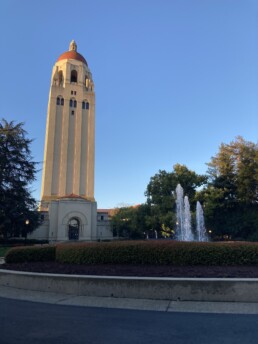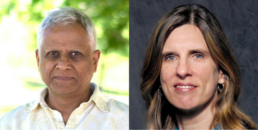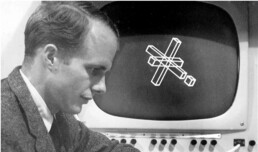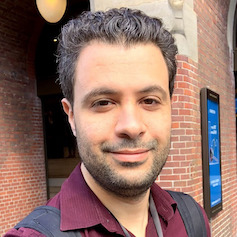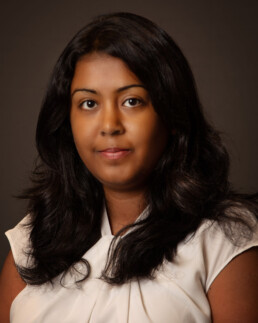Kahlert School Ph.D. Student Noelle Brown Presents Work on Ethics & Technology at the Embedded Ethics conference
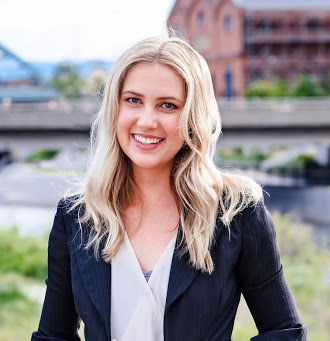
How can we teach computer science students about the ethical implications of technology? PhD student Noelle Brown is synthesizing the state of the field regarding this issue and presented her work at Stanford’s Embedded Ethics conference held on March 7, 2023 at Stanford University. This invitation-only conference shared strategies and research on teaching ethics and responsible computing within undergraduate computer science courses. Brown attended the conference with her advisor, professor Eliane Wiese.
“Noelle was the only student to present. It’s great to see her as an emerging leader in our field."
- Prof. Elian Wiese
Brown and Wiese’s broader research explores how to teach ethics to computer science students in a way that deepens technical rigor. They want to make it easier for computer science faculty to create instruction and assignments that weave ethics across the computer science curriculum. Rather than designing one-off assignments, Brown and Wiese aim to create an instructional design process that any computer science instructor can follow to make materials suited to their courses.
Brown presented a work-in-progress lightning talk, in which she discussed how researchers have reported on teaching ethics within computing over the past 40 years. Brown worked with her collaborator Benji Xie, an Embedded EthiCS Postdoc Fellow at Stanford, to read and analyze nearly 100 research papers on the topic.
Wiese described the motivation behind this project: “This is a great time to reflect on the state of research on incorporating ethics into computer science education. Our community has called for more ethics in computer science, and we’re doing it. Now that we know it’s possible in many different formats, our field can start investigating more specific questions, such as what formats are most effective for what purposes.”
Brown’s talk offered insight into how the computer science field has historically embedded ethics within technical courses, providing calls to action based on her results. “Even though we have been talking about teaching ethics in computer science for decades and many people understand why it is important to teach students how to think about their responsibilities as programmers, there are no guidelines for how an instructor should achieve this objective. By systematically analyzing the existing literature, we found that many people are teaching ethics, but they are doing it in a lot of different ways. Synthesizing this information provides instructors and educators with more focused research directions, such as defining what they are teaching as ‘ethics’ and suggesting ways to overcome the associated challenges,” Brown said.
The conference brought together academics from a variety of institutions who embed ethics within their technical courses. The event included panels and talks from experts on embedded ethics, discussing program approaches and goals, institutional buy-in, and instructional strategies. Attendees included a mix of academics from computer science and philosophy, emphasizing the importance of collaborations between these two disciplines. “The conference pulled together researchers and instructors from different institutions, fields, and perspectives, and fostered a healthy exchange of ideas,” Wiese shared. Some of the ideas explored at the conference include the importance of historical context for understanding algorithmic discrimination, the need for rigorous assessment of student learning, and shared resources for embedded ethics.
A recording of the conference is available online. Brown’s presentation can be found from 3:33:25 - 3:39:40.
National Science Foundation Selects the Kahlert School to Serve as the Site for Engaging Undergraduates in Research on Trust and Reproducibility of Intelligent Computation
The National Science Foundation has awarded a prestigious new research experience for undergraduates (REU) site to the Kahlert School of Computing entitled Trust and Reproducibility of Intelligent Computation (TREU). Led by Principal Investigator Prof. Ganesh Gopalakrishnan and Co-Principal Investigator and Director of the School Prof. Mary Hall (pictured above), the TREU REU site will train undergraduate students over 10 weeks during each of its three years. The selected students will learn valuable technical and soft skills to help them to become future leaders in the field of intelligent computational research.

Top Row: Profs. Bhaskara, Eide, Elhabian
Middle Row: Profs. Phillips, Sadayappan, Sundar
Bottom Row: Profs Wiese, Wiese, Zhang
“TREU offers our trainees a unique opportunity to learn about four prominent driving forces behind today's scientific research and connected living, namely high-performance computing and machine learning, cloud, and wireless networking. These topics are prominently represented at the Kahlert School through world-class faculty members and state-of-the-art research facilities. The learning experience will be contextualized and delivered around the themes of responsible research and inclusion.”
- Prof. Ganesh Gopalakrishnan, Principal Investigator
The TREU program will introduce trainees to the basics of many exciting and crucially important computer science research areas. The program emphasizes hands-on demonstration of these technologies and methods to enhance trust and reproducibility. In addition to a wide variety of technical skills, the program will equip trainees to apply the skills in an ethical, inclusive manner.
Students will gain exposure to several concepts throughout the program. Highlights include High-Performance Computing (HPC), image classification using machine learning, advanced wireless networking in the context of the POWDER project, ethics & inclusion, and research training. For a more detailed description of course modules, please visit https://treu.cs.utah.edu/. In addition, trainees will have frequent opportunities to help build their social and academic network while taking advantage of Utah’s abundant and unique natural resources.
“TREU allows the Kahlert School of Computing to build on the multi-million dollar research infrastructure that is University of Utah is uniquely blessed with thanks to prior flagship NSF projects such as Cloudlab and POWDER. We are excited to invite top students from across the nation to spend ten weeks on our beautiful campus over three successive years, and experience world-class research in a picture postcard setting. As is well-known, individuals who have spent time at the University of Utah are our best long-term ambassadors.”
- Prof. Mary Hall, Director, Co-Principal Investigator
TREU welcomes applications from undergraduates across the country at all levels. Students from backgrounds underrepresented in computer science, sophomores or juniors with knowledge of computer science basics, and students interested in graduate school are especially encouraged to apply. Applications close on April 15, 2023.
50th Anniversary of Computing at the University of Utah and IEEE Milestone Event
50th Anniversary of Computing at the University of Utah and IEEE Milestone Event (March 23-24, 2023). This once-in-a-lifetime two-day event, which is open to the public, will be held in the ballroom of the University of Utah’s Cleone Peterson Eccles Alumni House, 155 S. Central Campus Drive, in Salt Lake City, Utah. Click here for event information and to RSVP. Events both days will also be livestreamed on the University of Utah’s YouTube channel at www.youtube.com/@universityofutah/streams.
Historic Celebrations
On Thursday, March 23, beginning at 10 a.m. MDT, the Kahlert School of Computing will be celebrating its 50th anniversary with a day-long series of talks and panel discussions about the past, present, and future of one of the country’s top-ranked computer science departments. Speakers will include Sutherland and Telle Whitney, co-founder of Grace Hopper Celebration of Women in Computing and Former CEO of the Anita Borg Institute.
The main event, hosted by the John and Marcia Price College of Engineering and IEEE, begins Friday, March 24 MDT, at 10 a.m. Catmull (co-founder of Pixar Animation), Warnock (co-founder of Adobe), Kay (Xerox PARC), Sutherland, Clark (founder of Netscape and Silicon Graphics) and other legendary researchers including Martin Newell, Jim Blinn, Henry Fuchs and Henri Gouraud will speak and participate in panel discussions about their beginnings at the U.
The morning session will conclude with the presentation of a bronze IEEE Milestone plaque to the University of Utah for its contributions to the development of computer graphics. The plaque will be installed on a granite pedestal on the south lawn of the Merrill Engineering Building. IEEE, the world’s largest professional technical organization, will present the plaque to John and Marcia Price College of Engineering Dean Richard B. Brown and Kahlert School of Computing Director Mary Hall.
Graphics Pioneers
They were a group of young, scrappy, but brilliant University of Utah computer science students and professors who changed the world.
Ed Catmull. John Warnock (pictured). Jim Clark. Alan Kay. Ivan Sutherland. Martin Newell. They are a just a handful of the luminaries in the late 1960s and 1970s who revolutionized computer graphics by inventing technologies that have aided and shaped countless industries today.
The “Camelot Era”
Led by then computer science professor Ivan Sutherland and David Evans (pictured, right), the University of Utah’s first computer science research program in graphics and interactive computing, these trailblazing graduate students researched and developed ground-breaking innovations in 3D objects and computer animation decades before “Toy Story.” Many have later called this nascent period at the U the “Camelot Era.”
From Martin Newell’s first 3D rendering of a ceramic teapot (famously known as the “Utah Teapot”) and Ivan Sutherland’s 3D model of his old Volkswagen Beetle, to Ed Catmull’s 3D animation of his own hand, these early advances in computer modeling would ignite a revolution that would lead to computer simulations, medical imaging, computer molecular graphics, computer-animated movies, video games and more.
As author Robert Rivlin wrote in his The Algorithmic Image: Graphic Visions of the Computer Age: “Almost every influential person in the modern computer-graphics community either passed through the University of Utah or came into contact with it in some way.”
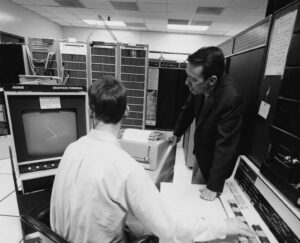
“The late David Evans was a true visionary to create a center of excellence in computer graphics and interactive computing in the mid 1960s,” said Kahlert School of Computing Director Mary Hall. “Early on, the atmosphere for creative innovation attracted the extraordinarily talented faculty, including Ivan Sutherland and Burroughs computer architect Bob Barton, and success followed from there.”
In the afternoon, beginning at 1:45 p.m. MDT, the College of Engineering will host a symposium in which these same graphics luminaries will give longer talks on their pioneering work.
“People interested in computing would love to hear from any one of these visionaries who launched the computer graphics revolution, but in this event, we will hear from a dozen of them!” Brown said. “It will be amazing!”
List of Speakers
James Blinn, Ph.D., 1978 — Created specular lighting models, bump mapping and environment mapping for surface textures in graphical images.
Ed Catmull, Ph.D., 1974 — Pioneer in computer animation who co-developed RenderMan rendering software. Co-founder of Pixar Animation Studios and winner of five Academy Awards.
Jim Clark, Ph.D., 1974 — Rebuilt the head-mounted display and 3D wand to see and interact with 3D graphic spaces. Founder of Netscape and Silicon Graphics.
Henry Fuchs, Ph.D., 1975 — Innovator in high-performance graphics hardware, 3D medical imaging and head-mounted display and virtual environments.
Henri Gouraud, Ph.D., 1971 — Created the Gouraud shading method for polygon smoothing — a simple rendering method that dramatically improved the appearance of 3D objects.
Alan Kay, Ph.D., 1969 — Envisioned the windowing graphical user interface at Xerox PARC, which led to the design of Apple MacIntosh and Windows computers.
Martin Newell, Ph.D., 1975 — Developed procedural modeling for 3D object rendering.
Co-developed the Painter’s algorithm for surface rendering.
Rodney Rougelot — Former president and chief executive officer of Salt Lake City-based Evans & Sutherland, which then developed military and aviation simulators with 3D graphics.
Robert A. Schumaker — An engineer with Evans & Sutherland who conceived a new architecture for rendering complex, high-quality 3D images for its flight simulators.
Alvy Ray Smith — Co-founder of Pixar Animation Studios. First Director of Computer Graphics for George Lucas’ Lucasfilm.
Ivan Sutherland, U Computer Science Professor, 1968-1974 — Inventor of Sketchpad, the first interactive graphics program with geometric constraints. Co-founded Evans & Sutherland with David Evans.
John Warnock, Ph.D., 1969 — Developed the Warnock recursive subdivision algorithm for hidden surface elimination. Co-founder of Adobe, which developed the Postscript language for desktop publishing and is now one of the largest software brands in the world.
Rezig El Kindi
El Kindi Rezig
Assistant Professor
elkindi@cs.utah.edu
WEB 2815
Website | Google Scholar
Research Interests
Data preparation, Data discovery, Data debugging, Information extraction, Data quality
Fariha Anna
Anna Fariha
Assistant Professor
afariha@cs.utah.edu
WEB 2851
Website | Google Scholar
Research Interests
Data systems usability, Explainable AI, Responsible data management, Data quality
50th Anniversary Celebration and IEEE Milestone
Celebrate our 50th anniversary and IEEE Milestone, March 23-24
Prof. Jason Wiese Receives Google Award for Inclusion Research
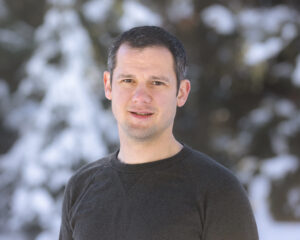
Kahlert School of Computing Assistant Professor Jason Wiese is a recipient of the 2022 Google Research Award for Inclusion Research aimed at developing personal tracking technology that addresses a major challenge faced by power wheelchair users: avoiding pressure ulcers. The research supported by the US $60K grant from Google will address the challenges they uncovered in their previous work in which they conducted interviews with users of powered wheelchairs to understand their experiences in adhering to the clinical recommendations and performing pressure reliefs throughout their days.
Personal tracking technologies, such as the activity trackers found on many phones and smartwatches, diet tracking applications, symptom trackers, and personal finance tools, have become commonplace. People use these technologies to gain better self-insight and make or sustain changes that improve their lives. Early versions of these tools typically focused on activities such as counting steps, which excluded people who use a wheelchair.
Over time, these tools have become more inclusive, for example, by adding the ability to track wheelchairs propelled manually by their users. However, as Professor Wiese’s recent work has shown, users of powered wheelchairs remain excluded from such personal tracking technologies and from research in general. To address this disparity, Prof. Wiese and his Ph.D. student Tamanna Motahar are collaborating with the Nielsen Rehabilitation Hospital to design and implement personal tracking technology with the goal of exploring better ways to serve users of powered wheelchairs. Professor Wiese explains: “Our goal is to make sure we design technology to specifically serve people who use powered wheelchairs, rather than assume that their needs are addressed by solutions that work for those who use manual wheelchairs or those without disabilities.” The research will leverage the incredible potential for technology designed with and for those who use powered wheelchairs and create a positive impact on their lives.
One major application for such technology relates to pressure ulcers, a common issue faced by individuals who use wheelchairs of all sorts. The mechanism behind a pressure ulcer is similar to bed sores, which can occur if someone lays in a bed for too long without getting out or changing position. In the context of wheelchairs, pressure ulcers can occur if somebody sits in their wheelchair for too long without changing position, shifting weight, or getting out. While users of manual wheelchairs and people with sufficient upper-body strength can do stretches or shift their weight to relieve pressure, it’s more complicated for people who have less upper body strength or function. In these cases, a “pressure relief” often requires tilting the chair back to a 45-degree angle for two minutes so that weight is shifted onto the person’s back.
Current clinical guidelines suggest that the procedure be performed every twenty minutes while a person is in the wheelchair, resulting in an estimated 30-50 pressure reliefs per day. Yet, people in wheelchairs may intentionally skip a pressure relief if it is infeasible or socially awkward to perform it in a given situation, such as being in a crowded place, traveling in a vehicle, participating in a meeting, etc. Often, they miss a pressure relief because they simply forget.
Wiese and Motahar will tackle this problem by exploring solutions for detecting pressure reliefs as well as providing users of power wheelchairs with real-time context-aware reminders and feedback. Their goal is to enable these individuals to view and reflect on their own behavior and its effect on their health and wellbeing.


